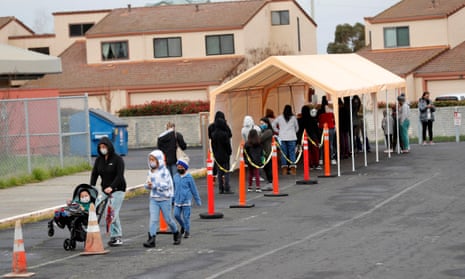As many as 20% of all child deaths from Covid in the US have occurred during the Omicron surge of the pandemic.
Children seem to be facing increasing risks from Covid-19 even as mask mandates drop across the country, and vaccination rates among children stall out at alarmingly low rates.
“We saw a massive surge of hospitalized young children during Omicron that we didn’t see in the earlier months of the pandemic,” said Jason Kane, a pediatric intensivist and associate professor of pediatrics at the University of Chicago Comer children’s hospital.
Omicron was first identified in November, and within weeks became the dominant variant in the US.
Since the beginning of the current year, 179 children have died from Covid-19 in the US, compared with 735 children in the preceding 20 months, according to data from the American Academy of Pediatrics (AAP). The figures mainly involve the age group 0-17 and were gathered from about May of 2020 to early March 2022.
The AAP collects data from states; a large majority, but not all, report child death numbers. This means the total could be higher – but this is unclear because some states include deaths of young people aged 18 and 19. Inclusion of this group, where mortality is greater than among younger children, could be distorting the picture for the core 0-17 cohort.
Figures similar to the AAP’s appear in the US Centers for Disease Control and Prevention (CDC) weekly provisional data on Covid deaths. From 2020 up to 9 March this year, a total is given of 894 deaths among those aged 0-17, of which 129 – almost 15% – have occurred since the start of 2022.
The Omicron variant may also affect younger children in different ways than previous versions of the virus. Omicron tends to infect the upper airways, which in children are narrower and can be more easily irritated.
“Omicron really did something different than Delta, and I don’t think it was just because more kids were infected,” Kane said. He saw younger patients with illnesses similar to croup and bronchiolitis, which can be dangerous in young children with “a pediatric airway the diameter of a pencil”, he said.
“It’s no longer fair even to insinuate that Covid doesn’t affect children, that Covid deaths are only in unhealthy children or kids with risk factors. That’s just not true, by the data.”
The under-five age group saw record-high hospitalizations over the past few months. Omicron hospitalization rates for kids under the age of five soared five times higher at Omicron’s peak than during the Delta wave, according to recent CDC research and data tables.
Among all ages of children, those under one may face the highest risk of severe disease, yet they are not able to take many of the precautions available to older people. Children under two cannot wear face masks, and children under five are not yet eligible for Covid vaccination.
Nearly 5 million children have been infected with Covid in 2022, and cases are now sharply declining. The majority of children who become infected with Covid have mild cases, and they are the population with the lowest death rate. That may change as variants evolve and emerge – Kane called it the “million-dollar question”.
“Omicron has been very bad for kids. We don’t know what future variants will do,” said Julia Raifman, assistant professor at the Boston University School of Public Health, who flagged the sharp uptick in Omicron deaths. “We don’t have a good enough understanding of what protection there is from prior infection, how long it lasts, how robust it is.”
In coming months, she said, “we’ll see a lot more infection, and more cases will always mean more hospitalizations and deaths,” especially with low vaccination rates.

Florida’s surgeon general recently recommended against vaccinating “healthy” kids given the possibility of side-effects, which remain extremely rare and are outweighed by the vaccines’ protection.
Vaccines are highly effective against severe illness, hospitalization and death for eligible children. But less than 30% of children between the ages of five and 11 are vaccinated in the US, and a little more than half of children 12 to 17 are vaccinated.
Preventive measures like masks should stay in place at schools and daycares, as well as parents’ workplaces and public transportation, in order to protect children as long as the virus is circulating, Raifman said.
“The kids who are too young to wear masks really need other people to reduce transmission around them,” she said.
Requiring face masks in schools during the Delta wave last fall helped reduce Covid cases by 23%, according to CDC research published on Tuesday.
A nationwide child vaccination campaign is very important as well, Raifman said – especially one in multiple languages that focuses on low-income communities where not enough families have gotten vaccinated.
Covid has hit marginalized communities harder – and vaccination rates and access to medical care tend to be lower in the same communities, creating a double whammy, Kane said.
Vaccines provide some protection against infection, which helps keep the virus from spreading, and they also offer excellent protection against hospitalization and death.
Vaccinating and boosting those who are eligible would help protect children too young to be eligible themselves, as well as providing other important benefits, Raifman said.
“We’ve never achieved high-enough vaccinations in the United States – we lag far behind other countries – and it makes us really vulnerable to continued high rates of death, hospitalization, societal disruption, economic disruption.”
And deaths are only one measure of Covid’s effects, she said. “Long Covid is also a concern for kids; the record-high hospitalizations are concerning for kids.”
Amid the fear and exhaustion of the Omicron surge, Kane’s overwhelming feeling was frustration, because proven measures are available to keep many children from becoming severely ill or dying.
“Kids shouldn’t die,” he said. “Kids shouldn’t die.”
